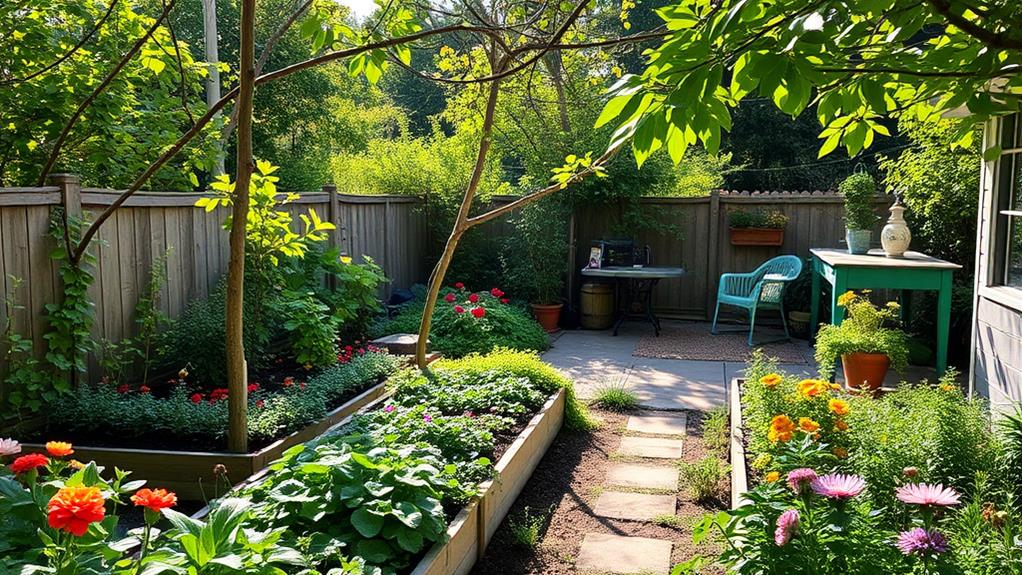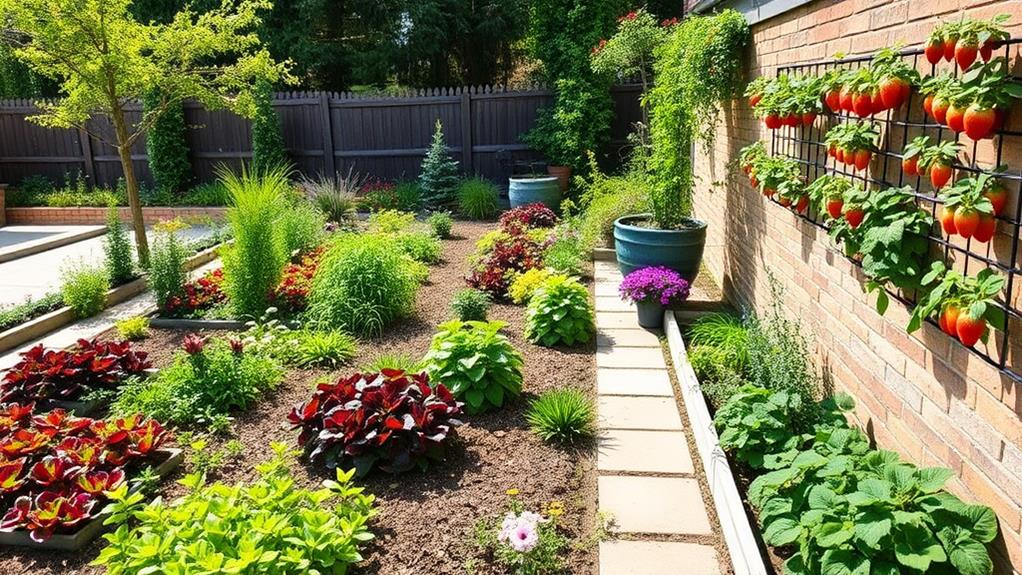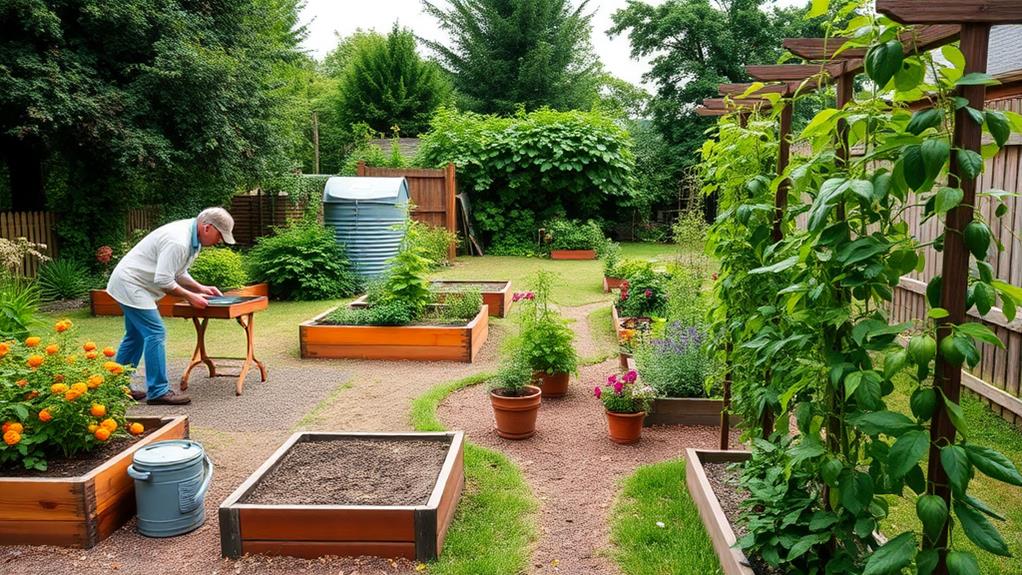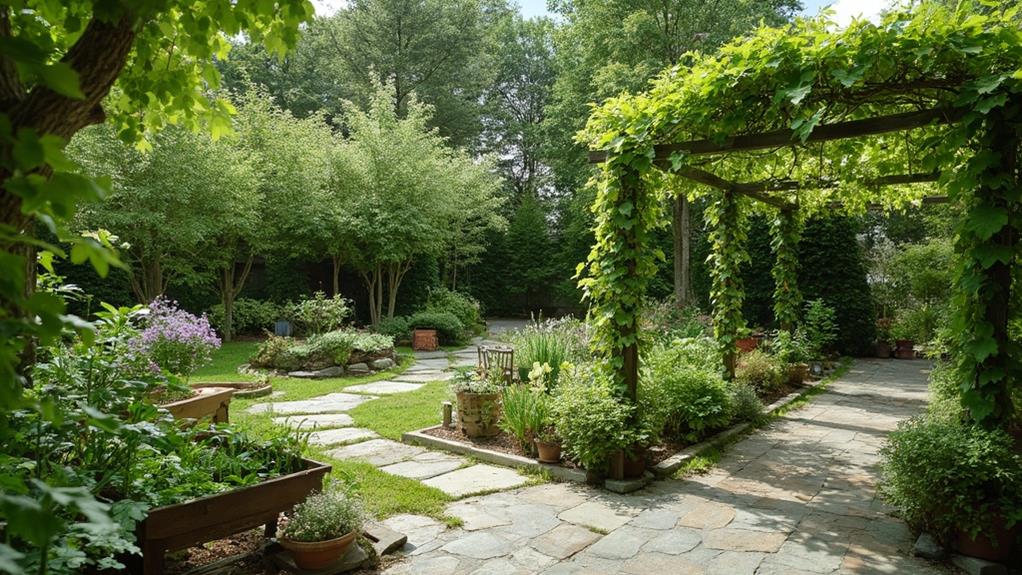Edible landscaping seamlessly blends ornamental and food-producing plants, creating functional and attractive outdoor spaces. This approach offers multiple benefits, including enhanced food security, reduced grocery bills, and increased biodiversity. By carefully planning your garden, selecting suitable plants, and applying design principles, you can transform your yard into a productive oasis. Fruit trees, berry bushes, herbs, and vegetables can be artfully integrated with existing landscape elements. Proper maintenance and care ensure a bountiful harvest, while thoughtful design principles maximize both aesthetics and productivity. Exploring edible landscaping opens up a world of possibilities for combining outdoor living with sustainable food production.
Benefits of Edible Landscaping

Sustainability meets aesthetics in the practice of edible landscaping. This innovative approach to outdoor design combines ornamental plants with edible varieties, creating functional and beautiful spaces. By integrating fruit trees, vegetables, and herbs into traditional landscaping, homeowners can enjoy fresh, homegrown produce while maintaining an attractive yard.
One of the primary benefits of edible landscaping is its contribution to food security and self-sufficiency. Growing food at home reduces reliance on grocery stores and long supply chains, ensuring access to fresh, nutritious produce. This practice also promotes biodiversity by incorporating a variety of plant species, which can attract beneficial insects and pollinators.
Edible landscapes can significantly reduce grocery bills and carbon footprints by minimizing transportation costs associated with store-bought produce. Additionally, they offer educational opportunities for children and adults alike, fostering a deeper connection to nature and food sources. The act of tending to an edible landscape can also provide physical exercise and stress relief, contributing to overall well-being. Moreover, these gardens can increase property values and create a sense of community by encouraging sharing of surplus produce with neighbors.
Planning Your Edible Garden
The foundation of a successful edible landscape lies in thoughtful planning. Begin by assessing your outdoor space, considering factors such as sunlight exposure, soil quality, and existing structures. Identify areas suitable for different types of edible plants, from fruit trees to herb gardens. Consider the mature size of plants and their spacing requirements to ensure optimal growth.
Next, select plants that suit your climate, taste preferences, and maintenance capabilities. Mix perennial and annual plants for year-round interest and production. Incorporate vertical elements like trellises or arbors to maximize space and add visual appeal. Plan for water sources and irrigation systems to ensure efficient watering.
Design with aesthetics in mind, creating focal points and balancing colors and textures. Group plants with similar water and sunlight needs together for easier maintenance. Include pathways for access and consider seating areas to enjoy your edible landscape.
Choosing the Right Plants

Selecting appropriate plants forms the cornerstone of a thriving edible landscape. Consider your climate, soil type, available sunlight, and personal preferences when choosing plants. Focus on a mix of perennials and annuals to ensure year-round productivity and visual interest.
Fruit trees, such as apples, pears, and citrus, serve as anchor plants and provide vertical elements. Incorporate berry bushes like blueberries, raspberries, and blackberries for both fruit production and attractive foliage. Herbs, including rosemary, thyme, and lavender, offer aromatic appeal and culinary versatility while requiring minimal maintenance.
For vegetable gardens, select a variety of leafy greens, root crops, and fruiting plants. Consider companion planting to maximize space and promote natural pest control. Incorporate edible flowers like nasturtiums and pansies for pops of color and garnishes.
Choose plants that complement your existing landscape and outdoor living areas. Consider the mature size of plants to ensure they fit well within your space. Opt for dwarf varieties of fruit trees or columnar forms if space is limited. By carefully selecting plants that suit your needs and environment, you can create a beautiful and productive edible landscape.
Design Principles for Edible Spaces
Once you've chosen the right plants for your edible landscape, it's time to consider how to arrange them effectively. Design principles for edible spaces focus on creating a functional and aesthetically pleasing environment that maximizes food production while enhancing outdoor living areas.
Start by considering the layout of your space, incorporating paths for easy access and maintenance. Group plants with similar water and sunlight requirements together to optimize resource allocation. Utilize vertical spaces with trellises, arbors, or espalier techniques for vines and climbing plants, maximizing productivity in limited areas.
Incorporate visual interest by varying plant heights, textures, and colors. Use herbs as borders or groundcovers to add both flavor and visual appeal. Consider seasonal changes and plan for year-round interest and production.
Integrate edible plants with existing landscaping elements, such as using fruit trees as focal points or incorporating berry bushes into hedgerows. Create outdoor living spaces within the edible landscape, such as seating areas surrounded by fragrant herbs or shaded by fruit trees.
Implement permaculture principles like companion planting and polycultures to promote biodiversity and natural pest control. Design with water conservation in mind, incorporating rainwater harvesting systems and efficient irrigation methods.
Maintenance and Care Tips

Maintaining an edible landscape requires regular attention and care to ensure optimal plant health and productivity. Regular watering, fertilizing, and pruning are essential tasks to keep plants thriving. Implement a consistent watering schedule, adjusting for seasonal changes and individual plant needs. Apply organic fertilizers or compost to nourish the soil and support plant growth.
Prune fruit trees and shrubs annually to maintain shape, encourage air circulation, and promote fruit production. Monitor for pests and diseases regularly, addressing issues promptly with organic solutions when possible. Practice crop rotation and companion planting to minimize pest problems and maximize soil health.
Mulch around plants to conserve moisture, suppress weeds, and regulate soil temperature. Harvest produce regularly to encourage continued production and prevent overripe fruits from attracting pests. Keep pathways clear and maintain proper spacing between plants to facilitate easy access for maintenance and harvesting.
Lastly, stay informed about the specific care requirements for each plant in your edible landscape. Different species may have unique needs for sunlight, soil pH, and pruning techniques. By following these maintenance tips, you can ensure a thriving and productive edible landscape.
Harvesting and Enjoying Your Produce
As the fruits of your labor begin to ripen, harvesting and enjoying your homegrown produce becomes the most rewarding aspect of maintaining an edible landscape. Timing is crucial for optimal flavor and nutrition. Most fruits and vegetables are best harvested in the morning after the dew has evaporated but before the heat of the day sets in. Learn the specific indicators for each crop's readiness, such as color changes, texture, and size.
Handle your produce gently to avoid bruising and store it properly to maximize freshness. Many herbs can be dried or frozen for later use, while fruits and vegetables may require different preservation methods like canning, pickling, or freezing. Consider sharing your abundance with neighbors or local food banks.
Incorporate your harvest into meals immediately for the freshest flavors. Experiment with new recipes that showcase your homegrown ingredients. Host outdoor dinners featuring dishes made entirely from your edible landscape. This not only provides a unique dining experience but also demonstrates the full potential of your garden. Remember to save seeds from heirloom varieties for next season's planting, completing the cycle of your edible landscape.
Frequently Asked Questions
How Do Edible Landscapes Affect Property Values?
Edible landscapes can positively impact property values by enhancing curb appeal, demonstrating sustainable living, and offering functional outdoor spaces. Well-designed food gardens can attract eco-conscious buyers, potentially increasing a property's marketability and overall value.
Can Edible Landscaping Attract Unwanted Wildlife or Pests?
Like a buffet for nature's diners, edible landscaping can indeed attract wildlife and pests. However, proper planning and maintenance can mitigate these risks. Implementing natural pest control methods and strategic plant selection helps balance beauty with functionality in your garden.
Are There Any Legal Restrictions on Edible Landscaping in Urban Areas?
Legal restrictions on edible landscaping in urban areas can vary by location. Some municipalities have ordinances limiting front yard vegetable gardens or tall crops. It's important to check local zoning laws and homeowners' association rules before implementing edible landscaping.
How Do Edible Landscapes Impact Water Consumption Compared to Traditional Gardens?
As the saying goes, "Every drop counts." Edible landscapes typically require more water than traditional gardens due to the higher water needs of fruit and vegetable plants. However, efficient irrigation systems and mulching can help mitigate increased consumption.
Can Edible Landscaping Be Incorporated Into Xeriscaping or Drought-Resistant Garden Designs?
Yes, edible landscaping can be integrated into xeriscaping and drought-resistant garden designs. By selecting water-efficient, edible plants and implementing smart irrigation techniques, gardeners can create sustainable landscapes that produce food while conserving water resources.
Conclusion
The edible landscape stands as a living canvas, blending sustenance with beauty. Like a well-tended orchard, it nourishes both body and soul, offering a bountiful harvest of fresh produce and aesthetic pleasure. This harmonious integration of form and function symbolizes humanity's reconnection with nature, transforming outdoor spaces into productive sanctuaries. As seeds of change, edible landscapes cultivate community, sustainability, and a deeper appreciation for the cyclical rhythms of growth and abundance in our everyday environments.

